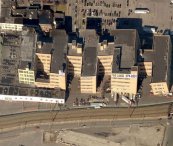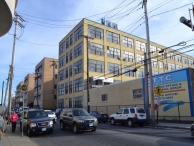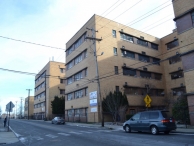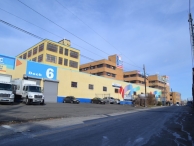Mill Record Bridgeport
RETURN TO ‘FIND MILLS’Disclaimer: Content for these properties was compiled in 2014-2017 from a variety of sources and is subject to change. Updates are occasionally made under Property Information, however the Connecticut Trust for Historic Preservation (dba Preservation Connecticut) makes no representation or warranty that the information is complete or up-to-date.
- Complex Name (Common)
- Singer Mfg. Co.
- Complex Name (Historic)
-
- Singer Mfg. Co.
- Address or Location
- 803 East Washington Avenue, Bridgeport
- County
- Fairfield
- Historic Designation
- Associated Mill Community
- n/a
 What can you do at this mill?
What can you do at this mill?
- Historic Information
Companies Associated w/Complex
- Singer Mfg. Co. 1916-1970
Use (Historic)
- Consumer Products, Small Appliances
- Fabricated Metal Products
- Machine Tools, Machinery
- Paper & Wood Products
Largest Documented Workforce
1,500 (1949).
Historic Narrative
The Singer Manufacturing Company was originally organized in 1851 as I.M. Singer and Company. The firm was founded by Isaac M. Singer, a mechanic and native of Pittsfield, New York, who, in 1850, devised an improved design for a sewing machine while repairing a model produced by the Lerow and Blodgett Company. Singer began production of his own machine in a small shop in Boston, Massachusetts, and in 1854 was joined by Edward Clark, an individual who possessed the talents for business needed to manufacture and market Singer’s product. Singer’s first sewing machine had its shortfalls, however, the firm both unveiled its first treadle-operated machine and introduced the concept of installment payment in 1856, effectively guaranteeing the company’s survival and place in history. The sewing machine devised by Singer was neither the first successful device of its kind, nor was it the most popular brand available in the United States during the company’s early years. Regardless, the firm pressed forward and Singer was prolific in developing a series of improved versions of his initial design. Singer and Clark incorporated the Singer Manufacturing Company in the state of New York after establishing a new plant there in 1863, and then in 1872 moved the company to Elizabethtown, New Jersey, where a massive plant employing some 6,000 hands was erected for the company. The Elizabethtown factory was the largest in the world devoted to the manufacture of a single product at the time of its construction, however, it was not large enough to keep up with the demand generated by the company’s army of salesmen and its global sales network. Additional plants were eventually built in Glasgow, Scotland in 1867; Clydebank, Scotland in 1882-1884; and Podolsk, Russia in 1902. Much of this growth was driven by the company’s development of the first marketable electric sewing machine in 1889. In 1905, the Singer Manufacturing Company acquired one its primary competitors, the Wheeler and Wilson Manufacturing Company of Bridgeport, Connecticut. Wheeler and Wilson was established in 1853 as a partnership between Allen B. Wilson of Willett, New York and Nathaniel Wheeler of Watertown, Connecticut. The firm was established in Watertown for the purpose of manufacturing a sewing machine developed by Wilson, however, after experiencing considerable early success the business was moved to the former Jerome Clock Company factory on Barnum Avenue in Bridgeport, Connecticut. The Wheeler and Wilson Manufacturing Company expanded the plant throughout the second half of the nineteenth century and by the early 1900s it extended from Helen Street the west to East Main Street. The Singer Manufacturing Company occupied the complex in 1907. The Singer Manufacturing Company posted average annual earnings of $20,000,000 throughout the 1920s, yet was severely impacted by the Great Depression. By the mid-1930s, however, the company had regained its footing and it carried this stability into the 1940s when the firm made considerable contributions to the Allied war effort through its production of bomb and artillery sights. The company won several service awards for this work from the United States Government, however, the post-war period saw an influx of foreign competition and the domestic sewing machine market collapsed by the late 1950s. The company tried to break into the aerospace and electronics industries during the 1960s and in 1963 the business was reorganized as the Singer Company. Sewing machine manufacturing in Bridgeport was discontinued in 1964 and the Singer Company sold its Barnum Avenue plant in 1970.
- Architectural Information
Number of Existing Buildings
Roughly seven (7) adjoining primary blocks.
Dates of Construction
1916, 1946, 1949, 1950, 1951, ca. 1960.
Architect
n/a
Builder
n/a
Building Type
Architectural Description
The former Singer Manufacturing Company plant is comprised of roughly seven adjoining primary blocks located on the south side of Barnum Avenue, and occupying the entire block framed by Barnum Avenue, East Main Street, East Washington Avenue, and Pembroke Street. The mill complex is the only surviving portion of what was once a massive facility, as numerous manufacturing and ancillary buildings built during the mid-to-late 19th and early 20th centuries and formerly located on the south side of Barnum Avenue between Helen and Pembroke Streets, and the north side of Barnum Avenue between Pembroke and Brooks Streets, were demolished during the 1960s. The core of the existing plant is formed by five three- and five-story manufacturing buildings linked by a central spine. The manufacturing blocks front on Barnum Avenue and, from west to east, were built in 1916, 1946, 1949, 1950, and 1951, respectively. The 1916 building is a five-story, 60’ x 242’ reinforced concrete structure with a concrete foundation, large rectangular window openings with concrete sills and lintels, multipane metal sash with triple-hung windows, concrete coping, and a flat roof. The 1946 block stands roughly 62’ to the east and adjoins the 1916 building via a five-story ell (part of the central spine). The 1946 block stands five stories tall and measures 60’ x 242’. Both it and the ell are of reinforced concrete construction with yellow brick facing. They have concrete foundations, rectangular window openings with concrete sills and lintels and multipane metal sash with pivot-style openings, concrete coping, and flat roofs. The windows in the manufacturing block are set in ribbon arrangements that are periodically interrupted by red brick panels. The window openings wrap around the northeast corner of the building and the concrete lintels project farther from the exterior plane of the building than the sills, thus creating a simple hood. The 1949 and 1950 blocks are nearly identical to the 1946 building, however, they measure 60’ x 242’ and 100’ x 242’, respectively. The design of the 1951 building diverges somewhat from that of its neighbors. This block is a three-story, 60’ x 242’ reinforced concrete structure that adjoins the 1950 block via a three-story ell. Both the main building and the ell have concrete foundations, rectangular window openings with concrete sills and lintels, multipane metal sash with pivot-style openings, concrete coping, and flat roofs. The window openings in the manufacturing block, however, do not wrap around the corner of the building as is seen in the blocks to the west and the windows are interrupted by concrete rather than red brick panels. The primary entrance to the 1951 building is centered on its west (side) elevation. This consists of a pair of metal doors set in a two-story concrete surround with a large metal and glass transom and sidelights. The two final primary blocks associated with the plant were erected ca. 1960. They are both of concrete block construction and stand one story in height. They wrap around the southwest corner of the complex and adjoin the west and south elevations of the 1916 building. The western of the two ca. 1960 blocks measures 80’ x 270’. It has a concrete foundation, small rectangular window openings with multipane metal sash, and a flat roof. The southern block is of a similar design yet measures roughly 260’ x 40’.
Exterior Material(s)
Structural System(s)
Roof Form
Roof Material
Power Source
Condition
Fair
Condition Notes
The complex is in fair condition. The vast majority of the original windows have been retained, however, many are in need of minor maintenance. Overall, however, the facility appears to be well maintained and structurally sound.
- Property Information
-
Specific Location
One 5.49-acre parcel (803 East Washington Avenue) located on the south side of Barnum Avenue, and occupying the entire block framed by Barnum Avenue, East Main Street, East Washington Avenue, and Pembroke Street.
Adjacent To
Exterior Visible from Public Road?
Yes
Parcel ID / Assessor Record Link
- 42/1774/1/A. / Link →
Acreage
5.49
Use (Present)
- Commercial
- Industrial
- Other: Bridgeport Trade & Technology Center (https://www.mybttc.com/)
- Vacant
- Sources
-
Form Completed By
Lucas A. Karmazinas
Date
01/22/2016
Bibliography
- List of Connecticut Manufacturers, 1922, 1924, 1930, 1932.
- Directory of Connecticut State Manufacturers, 1936, 1939.
- Industrial Directory of Connecticut, 1947.
- Register of War Production Facilities in Connecticut, 1951.
- Map of Fairfield County; Baker, William A., 1854.
- Atlas of the City of Bridgeport; J.B. Beers & Co., 1876.
- Atlas of the City and Town of Bridgeport; G.M. Hopkins & Co., 1888, 1917.
- Atlas of Bridgeport; Kershaw, William H., 1910.
- Sanborn Map Company, 1884, 1888, 1898, 1904, 1913, 1939, 1950.
- Aerial Survey of Connecticut, 1934, 1951, 1965, 1970, 1985.
- Bridgeport City Directory, Various editions.
- Hartford Courant, 1935, 1945.
- A History of the Old Town of Stratford and the City of Bridgeport; Orcutt, Samuel, 1886.
- History of Bridgeport and Vicinity; S.J. Clarke Publishing, 1917.
- Representative View(s)Click on image to view full file








